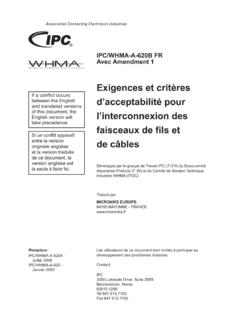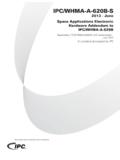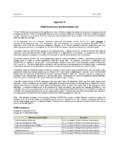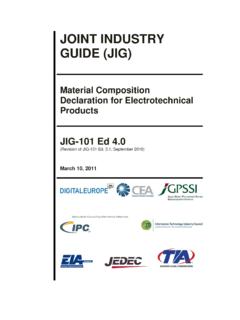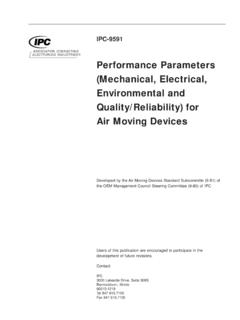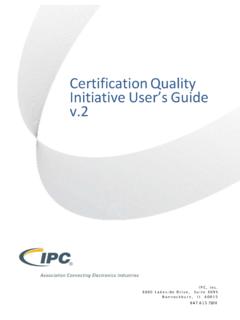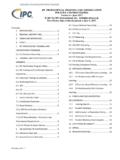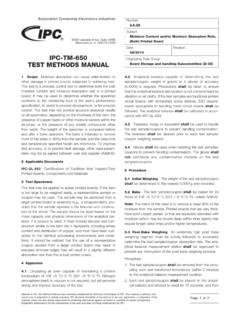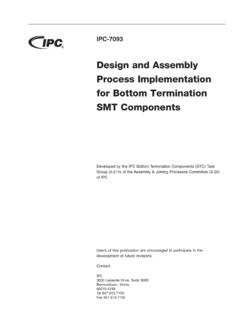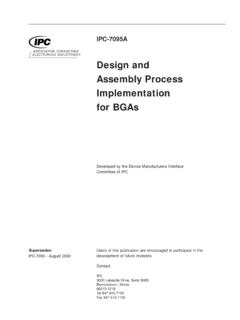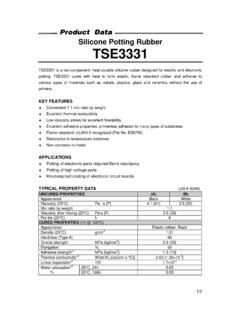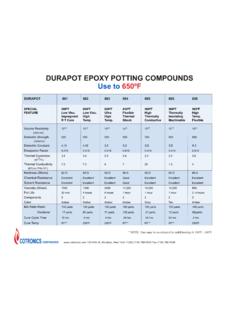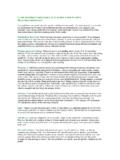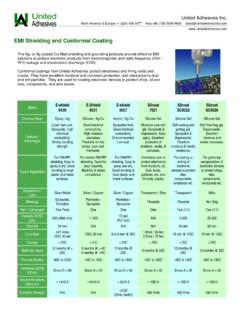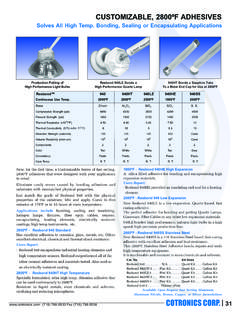Transcription of IPC-HDBK-850 (5-33F) Guidelines for Design, …
1 IPC-HDBK-850 (5-33F) Guidelines for Design, Selection and Application of potting Materials and encapsulation Processes Used for Electronics Printed Circuit Board Assembly 1. SCOPE Introduction potting and Encapsulation is a very broad topic and can include anything from toys to high power applications. There is no clear industry-wide definition that would decipher distinct differences between either. Because of this, this document will cover all known terminology associated with this process as related only to electronic printed circuit board assembly and protection. Encapsulation is used in conjunction with various types of assemblies ( , printed circuit assemblies (PCA), and components ( , connectors, transformers, etc.). The designer and the users of encapsulation for electronics applications must be aware of the properties of various types of encapsulation and their interactions with assemblies and components in order to protect them in the end-use environment for the design-life of the end item.)
2 This document has been written to assist the designers and users of encapsulation in understanding the characteristics of various encapsu lation types, as well as the factors that can modify those properties when the encapsulation is applied. Understanding and accounting for these materials can ensure the reliability and function of electronics. Purpose The terms potting and encapsulation (P&E) can be confusing terms and be interpreted to mean many things in various industry assembly processes. The purpose of this handbook is to assist the individuals who must either make choices regarding encapsulation or who must work in encapsulation operations and to provide Guidelines for the design, selection and application of potting and Encapsulation as it pertains to electronic components and printed board assembly only. Scope For the purpose of this document potting can be thought of as the liquid material and encapsulation can be interpreted as the application process and cure.
3 Please keep in mind however that the terms potting and encapsulation are commonly interchanged with each other in a variety of electronic protection processes. Encapsulation, for the purpose of this document, is defined as a potting material ( epoxy, silicone, urethane) that is applied in a liquid state and subsequently processed ( , cured) to form a rigid or rubber-like state. Processing characteristics and curing mechanisms are dependent on the encapsulation chemistries used. The desired performance characteristics of an encapsulation depend on the application and must be considered when selecting encapsulation materials and encapsulation processes. Users are urged to consult the suppliers for detailed technical data. This guide enables a user to select an encapsulant based on industry experience and pertinent considerations. It is the responsibility of the user to determine the suitability, via appropriate testing, of the selected encapsulation and application method for a particular end use application.
4 Encapsulation may have several functions depending on the type of application. The most common are: To inhibit current leakage and short circuit due to humidity and contamination from service environment To inhibit corrosion To improve fatigue life of solder joints to leadless packages To inhibit arcing and corona, in particular for high voltage applications To provide mechanical support and to prevent damages due to mechanical shock and vibration. To provide a mitigation method for the growth of tin-whiskers. Terms and Definitions The following are examples of some of the terms typically associated with these types of potting and encapsulation protection processes as related to the electronics assembly process. Material Terms and Definitions Catalyst A chemical which accelerates the cure (or cross linking) of a resin system. Conformal Coating An insulating protective covering and electrical insulation that conforms to the configuration of the objects coated ( printed boards, printed board assembly) providing a protective barrier against deleterious effects f rom environmental conditions.
5 Diluents A material used in extending the volume of material or adjusting viscosity. A diluent can be reactive or non-reactive. Encapsulant See potting Compound, Glob Topped Encapsulation , or Molding Compound (See figures 1-1, 1-2, 1-3, & 1-4) Fi gure 1-1 potting Material in a Syringe Figure 1-2 Injecting potting Material onto a Module (Encapsulation) Figure 1-3 Encapsulation Curing in Oven Fi gure 1-4 Encapsulation of Pins Inside Connector Shell Filler An insoluble material used to extend the volume of a compound, reduce cost or modify thermal, physical and electrical properties; also used to modify thixotrophy. During initial inquiries to formulators, consideration should be given to the types of fillers that may provide the desired properties for the application, as well as how these fillers may impact the choice of a suitable meter/mix system, and compatibility with the potting material.
6 (See figure 1-5) Fi gure 1-5 Example of Silica Filler being added to Epoxy as a Percentage by Weight Note: Filler material increases viscosity of potting material and modifies durometer value after cure. Filleting Compound A liquid potting material (staking material) used to surround and seal the gap or stand-off area under a component. It can also be used to enhance, stabilize, and provide mechanical support for larger components; also referred to as a staking material. Glob Top A high viscosity or low-flowable liquid potting material usually used to encompass wire bonds at the bare die level. The glob top material provides for protection from moisture, shock and vibration, CTE mismatch, and replaces the conventional interposer package. See figure 1-6 Fi gure 1-6 Cut-Away View of Glob Top Wire Bond Encapsulation (Image Courtesy of Loctite) Hardener A chemical, sometimes referred to as a catalyst, added to a thermosetting resin for the purpose of causing curing or hardening.
7 Molding Compound Material used in conjunction with a mold for encapsulation. See also potting Compound . Glob-topped encapsulants consist of very viscous compounds that are usu ally applied to a PB or substrate. Pigment An insoluble material used to color a compound. Plastic Any of a group of synthetic or natural organic compounds produced by polymerization, optionally combined with additives (organic or inorganic fillers, modifiers, etc) into a homogeneous material capable of being molded, extruded, coated, or cast into various shapes and films. potting - potting is a material used in the encapsulation process which involves the surrounding of a component(s) or an assembly in a container with a liquid resin which is then cured in place. The container usually becomes an integral part of the system such that the critical property that needs to be maintained is the interfacial adhesion between the cured resin system, the container substrate and critical components within an optimum long-lasting reliable package.
8 Figure 1-7 illustrates a potted assembly Fi gure 1-7 Example of Encapsulated CCA Inside of Container ( potting Shell) potting Compound The liquid material chosen for the potting application that is applied and cured to the manufacturer s recommendation. Chemistry chosen (epoxy, polyurethane, silicone, etc.) will be customer and application specific. Primer A material used to improve or enhance the chemical coupling or bonding of a polymeric material to a substrate. Release Agent A material used to aid in the de-molding of a part from a mold. Resin A natural or synthetic resinous material. Underfill A compound used to fill the area under various electronic devices. Underfill is commonly used to minimize stress differentials (CTE) between components and substrates, most often area array components. Application Terms and Definitions Adhesion The ability of a material to adhere or bond to a substrate.
9 The surface energy of both substrate and the liquid being applied are critical factors in obtaining adequate adhesion. Cleanliness of the surfaces is paramount to prevent delamination. In protection chemistry applications, (conformal coatings & potti ng materials), adhesion is critical to provide a barrier against moisture other contaminants. Some materials have no chemical adhesion, yet they do have some level of adhering to the substrate. Interfacial wet-out provides the barrier, adhesion is desired to provide a more permanent wet-out condition. Ex; A decent coating of oil can protect metal from moisture and corrosion via wet- out. See paragraph for more information on adhesion. Figure 1-8 Results of Poor Adhesion Adhesion Promotion - The chemical process of preparing a surface to enhance its ability to be bonded to another surface, A layer of encapsulation Adhesion Failure Adhesive Failure: The rupture or bond failure of an adhesive bond such that the separation appears to be at the adhesive-adherent interface.
10 Cohesive Failure: The separation of the encapsulation material from itself. Air Dry Air dry is associated with the act of a liquid or semi-liquid material becoming a solid at room temperature. It is typically the act of a solvent or solvents evaporating from a liquid matrix to create a solid film. Another example could be a liquid material that can cure at ambient room temperature, su ch as an acrylic. Temperature and relative humidity both play a role in how fast this can be achieved. Air Line Flexible tubing or rigid piping of various forms that route the flow of gases, (air, nitrogen, or other), to components of equipment systems in the encapsulation process. Anisotropic Conducting in the Z-axis only. AR/UR Abbreviation standing for acrylic resin and urethane resin combination chemistries. Automated Optical Inspection (AOI) Equipment Inspection devices used to examine the surface of target areas.
